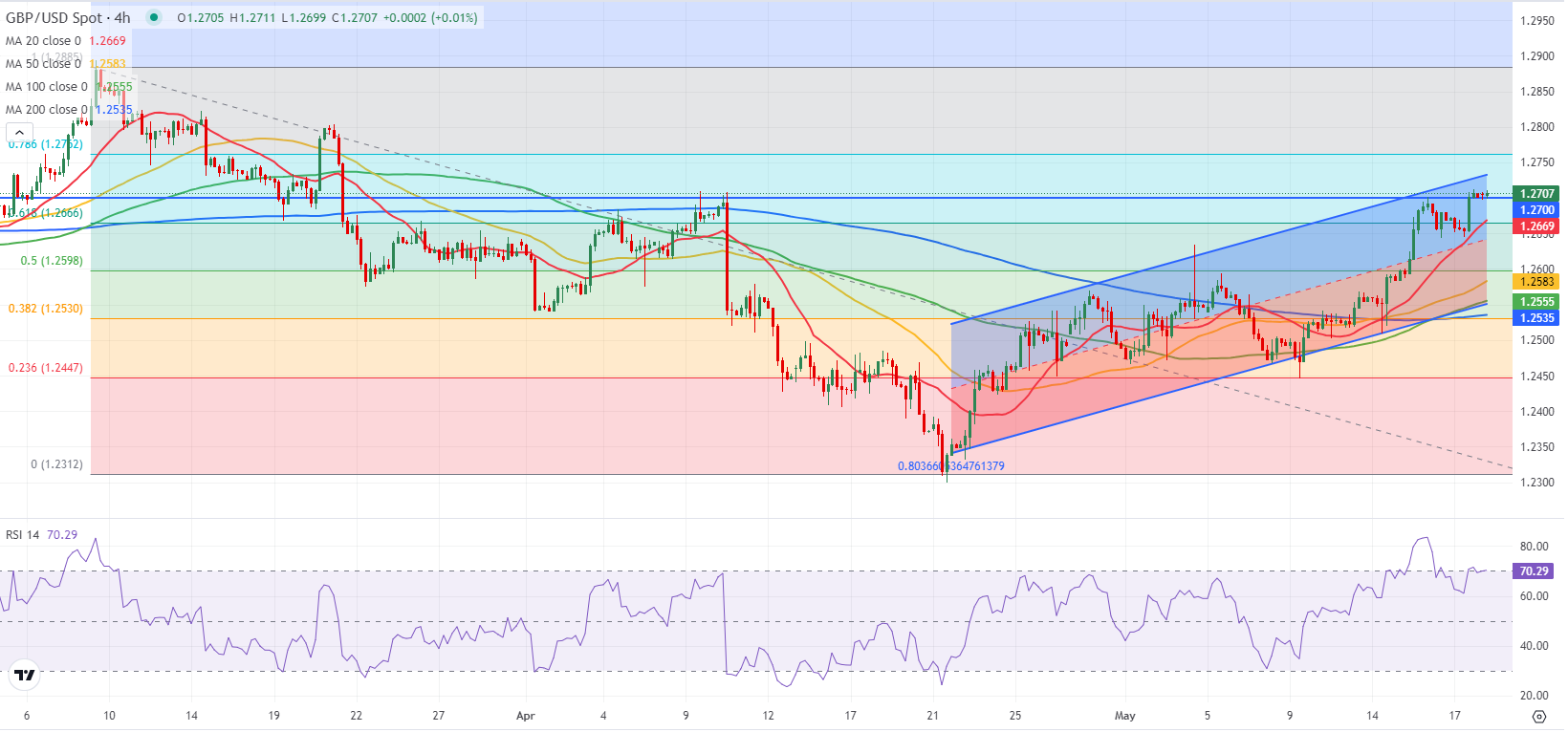- GBP/USD trades in a narrow channel at around 1.2700 in the European morning.
- The pair remains bullish in the near term but it's close to turning technically overbought.
- Fed policymakers will be delivering speeches later in the day.
GBP/USD seems to have entered a consolidation phase near 1.2700 at the beginning of the week. In the absence of macroeconomic data releases, market participants will continue to scrutinize comments from Federal Reserve (Fed) officials.
Following a short-lasting downward correction on Thursday, GBP/USD regained its traction and reached its highest level in nearly two months above 1.2700 on Friday. On a weekly basis, the pair rose 1.4%.
British Pound PRICE Last 7 days
The table below shows the percentage change of British Pound (GBP) against listed major currencies last 7 days. British Pound was the strongest against the Swiss Franc.
| USD | EUR | GBP | JPY | CAD | AUD | NZD | CHF | |
|---|---|---|---|---|---|---|---|---|
| USD | -1.02% | -1.43% | 0.00% | -0.44% | -1.44% | -1.71% | 0.30% | |
| EUR | 1.02% | -0.47% | 1.02% | 0.56% | -0.46% | -0.71% | 1.30% | |
| GBP | 1.43% | 0.47% | 1.40% | 1.03% | 0.00% | -0.25% | 1.77% | |
| JPY | 0.00% | -1.02% | -1.40% | -0.45% | -1.40% | -1.75% | 0.33% | |
| CAD | 0.44% | -0.56% | -1.03% | 0.45% | -0.99% | -1.28% | 0.65% | |
| AUD | 1.44% | 0.46% | -0.01% | 1.40% | 0.99% | -0.36% | 1.78% | |
| NZD | 1.71% | 0.71% | 0.25% | 1.75% | 1.28% | 0.36% | 2.03% | |
| CHF | -0.30% | -1.30% | -1.77% | -0.33% | -0.65% | -1.78% | -2.03% |
The heat map shows percentage changes of major currencies against each other. The base currency is picked from the left column, while the quote currency is picked from the top row. For example, if you pick the British Pound from the left column and move along the horizontal line to the US Dollar, the percentage change displayed in the box will represent GBP (base)/USD (quote).
The renewed selling pressure surrounding the US Dollar (USD) fuelled the pair's rally last week. Following the Producer Price Index (PPI) and Consumer Price Index (CPI) data for April, investors started to price in a Fed policy pivot in September and forced the USD to come under pressure. According to the CME FedWatch Tool, markets see a 35% chance that the Fed will leave the policy rate unchanged in September.
Later in the day, several Fed officials, including Atlanta Fed President Raphael Bostic, Fed Governor Christopher Waller and Fed Vice Chair Phillip Jefferson, will be delivering speeches. If policymakers downplay the progress seen in inflation in April and repeat that the policy will need to remain restrictive for longer, the USD could stay resilient against its peers and limit GBP/USD's upside.
On Wednesday, the UK's Office for National Statistics will release inflation data for April. Later in the American session, the Fed will release the minutes of the April 30-May 1 policy meeting.
GBP/USD Technical Analysis
GBP/USD trades within the upper half of the ascending regression channel coming from late April but the Relative Strength Index (RSI) indicator on the 4-hour chart stays slightly above 70, suggesting that the pair could make a technical correction before stretching higher.
On the downside, 1.2700 (psychological level, static level) aligns as immediate resistance before 1.2670-1.2660 (Fibonacci 61.8% retracement of the latest downtrend, mid-point of the ascending channel) and 1.2600 (static level).
In case GBP/USD holds above 1.2700 and confirms this level as support, 1.2730 (upper limit of the ascending channel) could be seen as next resistance before 1.2760 (Fibonacci 78.6% retracement) and 1.2800 (psychological level, static level).
Pound Sterling FAQs
The Pound Sterling (GBP) is the oldest currency in the world (886 AD) and the official currency of the United Kingdom. It is the fourth most traded unit for foreign exchange (FX) in the world, accounting for 12% of all transactions, averaging $630 billion a day, according to 2022 data. Its key trading pairs are GBP/USD, aka ‘Cable’, which accounts for 11% of FX, GBP/JPY, or the ‘Dragon’ as it is known by traders (3%), and EUR/GBP (2%). The Pound Sterling is issued by the Bank of England (BoE).
The single most important factor influencing the value of the Pound Sterling is monetary policy decided by the Bank of England. The BoE bases its decisions on whether it has achieved its primary goal of “price stability” – a steady inflation rate of around 2%. Its primary tool for achieving this is the adjustment of interest rates. When inflation is too high, the BoE will try to rein it in by raising interest rates, making it more expensive for people and businesses to access credit. This is generally positive for GBP, as higher interest rates make the UK a more attractive place for global investors to park their money. When inflation falls too low it is a sign economic growth is slowing. In this scenario, the BoE will consider lowering interest rates to cheapen credit so businesses will borrow more to invest in growth-generating projects.
Data releases gauge the health of the economy and can impact the value of the Pound Sterling. Indicators such as GDP, Manufacturing and Services PMIs, and employment can all influence the direction of the GBP. A strong economy is good for Sterling. Not only does it attract more foreign investment but it may encourage the BoE to put up interest rates, which will directly strengthen GBP. Otherwise, if economic data is weak, the Pound Sterling is likely to fall.
Another significant data release for the Pound Sterling is the Trade Balance. This indicator measures the difference between what a country earns from its exports and what it spends on imports over a given period. If a country produces highly sought-after exports, its currency will benefit purely from the extra demand created from foreign buyers seeking to purchase these goods. Therefore, a positive net Trade Balance strengthens a currency and vice versa for a negative balance.
Information on these pages contains forward-looking statements that involve risks and uncertainties. Markets and instruments profiled on this page are for informational purposes only and should not in any way come across as a recommendation to buy or sell in these assets. You should do your own thorough research before making any investment decisions. FXStreet does not in any way guarantee that this information is free from mistakes, errors, or material misstatements. It also does not guarantee that this information is of a timely nature. Investing in Open Markets involves a great deal of risk, including the loss of all or a portion of your investment, as well as emotional distress. All risks, losses and costs associated with investing, including total loss of principal, are your responsibility. The views and opinions expressed in this article are those of the authors and do not necessarily reflect the official policy or position of FXStreet nor its advertisers. The author will not be held responsible for information that is found at the end of links posted on this page.
If not otherwise explicitly mentioned in the body of the article, at the time of writing, the author has no position in any stock mentioned in this article and no business relationship with any company mentioned. The author has not received compensation for writing this article, other than from FXStreet.
FXStreet and the author do not provide personalized recommendations. The author makes no representations as to the accuracy, completeness, or suitability of this information. FXStreet and the author will not be liable for any errors, omissions or any losses, injuries or damages arising from this information and its display or use. Errors and omissions excepted.
The author and FXStreet are not registered investment advisors and nothing in this article is intended to be investment advice.
Recommended Content
Editors’ Picks

AUD/USD: The hunt for the 0.7000 hurdle
AUD/USD quickly left behind Wednesday’s strong pullback and rose markedly past the 0.6900 barrier on Thursday, boosted by news of fresh stimulus in China as well as renewed weakness in the US Dollar.

EUR/USD rebounds on Thursday after midweek pullback
EUR/USD tuned back into the high end on Thursday, getting bolstered by a broad-market selloff in the Greenback. US data that printed better than expected helped to ease concerns of a possible economic slowdown within the US economy looming over the horizon.

Gold holding at higher ground at around $2,670
Gold breaks to new high of $2,673 on Thursday. Falling interest rates globally, intensifying geopolitical conflicts and heightened Fed easing bets are the main factors.

Ethena Labs launches new UStb stablecoin backed by BlackRock's BUIDL token
Ethena Labs announced on Thursday that it has released a new stablecoin product, UStb. The new stablecoin will be fully collateralized by BlackRock's USD Institutional Digital Liquidity Fund and function similarly to a traditional stablecoin.

RBA widely expected to keep key interest rate unchanged amid persisting price pressures
The Reserve Bank of Australia is likely to continue bucking the trend adopted by major central banks of the dovish policy pivot, opting to maintain the policy for the seventh consecutive meeting on Tuesday.

Five best Forex brokers in 2024
VERIFIED Choosing the best Forex broker in 2024 requires careful consideration of certain essential factors. With the wide array of options available, it is crucial to find a broker that aligns with your trading style, experience level, and financial goals.
